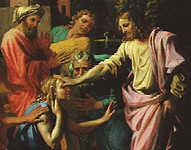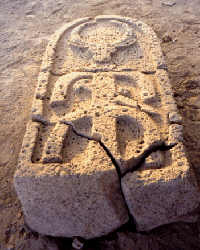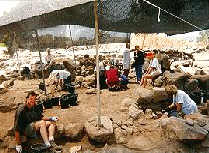|
with Dr. Elizabeth McNamer of Rocky Mountain College Bethsaida [bayth-SAHee-dah'] was a fishing village located on the shores of the Sea of Galilee where the Jordan River enters the sea. Today Bethsaida is the only place where one can actually see the remains of an entire city of the biblical era which has not been destroyed and reconstructed in intervening centuries. Bethsaida provides scholars a first hand look at life 2000 years ago. Questions are being answered as to what happened to Bethsaida during the Roman-Jewish War and what the world of Jesus and his apostles was like. Bethsaida is one of the most frequently mentioned towns in the New Testament – the birthplace of the apostles Peter and Andrew and the home of the apostle Philip. Theodosius (530 CE), claims that Bethsaida was also the home of the fisherman Zebedee and his sons James and John.  According to the New Testament, Bethsaida was the site of the feeding of the multitudes, healing of the blind man and near its shores Jesus was seen walking on the waters.
According to the New Testament, Bethsaida was the site of the feeding of the multitudes, healing of the blind man and near its shores Jesus was seen walking on the waters.
In the writings of Roman historian Josephus, we also find mention of the city of Bethsaida. After the successful (but short-lived) revolts of the Maccabees in 164 BCE, Bethsaida passed into the hands of the Hasmoneans and later into the Roman empire and the Herodian families. Philip Herod, son of Herod the Great, ruled the general area (Golan) and rebuilt Bethsaida in the first part of the first century CE and renamed it: Bethsaida Julias. At the time of the Roman wars (67-70 a.d) it was destroyed along with most other towns in Galilee. But unlike other towns (Capernaum and Chorzin for example) Bethsaida did not rebuild. Sometime after the first century, the city was lost. The Lost City of Bethsaida For nearly two millennia the location of Bethsaida remained a mystery to crusaders, pilgrims, and scholars. By the Fourth Century CE, many of the sites associated with the New Testament had been discovered, except Bethsaida. No one place was consistently identified as Bethsaida. Researchers have uncovered 27 pilgrim accounts that describe their attempts to find the city. By the 1800's archeology as a science began to develop and two theories emerged as to the location of Bethsaida: The Discovery  In the early 1980's a Benedictine monk and archaeologist, Father Bargil Pixner, began a personal search for Bethsaida. Combing the scriptures and other historical records for clues, he determined that a mound known as et-Tell (literally, the mound) set back from the Sea of Galilee two miles, must be the site of Bethsaida. He published a landmark article in the Biblical Archaeological Review in 1985. Many experts said he was wrong, that the site was too far from the sea. Then investigations from 1989 to 1993, have confirmed earlier suspicions that the Sea of Galilee had changed in size and that ancient Bethsaida was in fact located near the Sea coast in Antiquity. In 1987 the Israeli government officially recognized et-Tell as the site of Bethsaida.
In the early 1980's a Benedictine monk and archaeologist, Father Bargil Pixner, began a personal search for Bethsaida. Combing the scriptures and other historical records for clues, he determined that a mound known as et-Tell (literally, the mound) set back from the Sea of Galilee two miles, must be the site of Bethsaida. He published a landmark article in the Biblical Archaeological Review in 1985. Many experts said he was wrong, that the site was too far from the sea. Then investigations from 1989 to 1993, have confirmed earlier suspicions that the Sea of Galilee had changed in size and that ancient Bethsaida was in fact located near the Sea coast in Antiquity. In 1987 the Israeli government officially recognized et-Tell as the site of Bethsaida.
The Dig at Bethsaida In 1991, the Bethsaida Excavation Project was formed with faculty directors and staff from institutions worldwide to supervise the recovery of the site. The Bethsaida Excavations Project is housed a the University of Nebraska at Omaha and has a goal of excavating ancient Bethsaida and producing in the coming years and original, multi- volume study of this intriguing, ancient and mysterious city.  Since 1987, Dr. Rami Arav has been excavating at the site and each year since that time, the site has yielded exciting new archeological discoveries. Since 1993, Dr. Elizabeth McNamer from Rocky Mountain College has taken groups to dig at this site. She will be taking another group next summer. The group will spend two weeks on the dig (stay at a kibbutz). On the weekends the group will visit other archaeological and Biblical sites. At the end of the dig there will be a four day stay in Jerusalem. The cost will be approximately $3000 (excluding credits). If Interested, Please Contact: For More Information on this Site: The Rocky Mountain College Bethsaida Page The Official Bethsaida Excavations Page With Jesus Through Galilee According to the Fifth Gospel by Bargil Pixner Bethsaida: A City by the North Shore of the Sea of Galilee Volume 1 Bethsaida: A City by the North Shore of the Sea of Galilee Volume 2 Bethsaida: Home of the Apostles Copyright © 2004 CenturyOne Foundation, Inc.– a Nonprofit Organization All Rights Reserved All materials contained in the CenturyOne Foundation Web Site are protected by copyright and trademark laws and may not be used for any purpose whatsoever other than private, non-commercial viewing purposes. Derivative works and other unauthorized copying or use of stills, video footage, text or graphics is expressly prohibited. |